Today I am going to give a progress report on work that was set in motion before we became immersed in a busy art/craft show and charitable work season that is still keeping us quite busy. I do not have the time I need to keep up with all my projects, but I have completed a couple and am making progress with others. J.D. gave you some idea of the activities we are involved with in an earlier post, so I am going to focus on specific pieces of work. Part of this explanation will be in the form of questions and answers.
Are you featuring any more women artists at this time?
Yes, I am — in two ways.
 |
| Frida Kahlo, USPS stamp |
First of all, we have another commemorative stamp. This one features Frida Kahlo. Born in Mexico in 1902, she was involved in the post-revolutionary times when Mexico was trying to adjust and develop a real sense of its nationalism. She showed artistic talent at a very early age, suffered polio as a child, determined to study for the medical profession. Her dreams and her body were shattered in an automobile accident while in her late teens. Sadly, that was to leave her in constant pain for the rest of her too-short life. She began painting again while confined to bed, using an apparatus that let her paint on a canvas directly above her. Later she became very politically active, especially in affairs concerning both Mexican and Native peoples. She was an out-spoken feminist. She married, divorced, and re-married famous painter Diego Rivera. Theirs was a stormy marriage. Frida's many self-portraits show both her physical and her emotional pain, but also an extreme determination not to give in to that pain.
She was considered a surrealist painter — and Surrealism was very popular at that time — but she denied it, saying that she only painted HER OWN reality. She was strongly influenced by Folk Art and included many costumes and artifacts in her paintings. Today, I think she would probably be grouped with the Magic Realists. She died at the age of forty-seven. She sold very few paintings during her life, although she painted portraits on commission. Today her paintings are worth a fortune.
Second, the way I am featuring contemporary artists is to show a project I have done that has been inspired by one of the artists I mentioned previously. This project was inspired by the African paintings and prints of British artist Tilly Willis.
Did you finish the project you designed of the Women's World Cup soccer players?
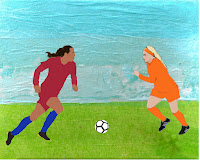 |
| Soccer players, original sketch |
It is still in progress on my work table. With shows every weekend, I'm running behind with some of my projects. but it is progressing when I have time to work on it. This has been quite a challenge for me. Those of you who are familiar with my work know that I like to work on a fairly large scale and put in a lot of detail. It was quite a change to go to a small scale with simply shaped pieces. Also, while I am working constantly with felt in making my puppets, everything is hand-stitched. To do that on this project would have obliterated the finer details. I have had no experience with fabric glues, so I still need to do some experimenting to get the right combinations of fabric and glue. But it has been fun and informative so far and I will certainly try more of these in the future.
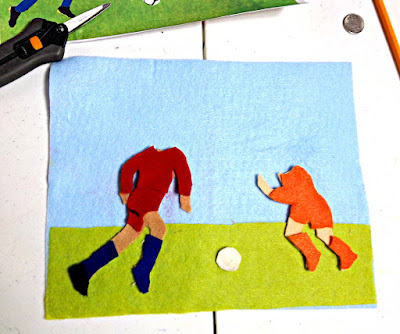 |
| Fabric version of WWC soccer players, in progress |
I can tell you had Tobin Heath in mind for the U.S. soccer player, but who was your model for the Dutch player?
I did indeed have Tobin in mind when I drew the U.S. player. After all, she went into this year's Cup with titles from more different competitions than any other player on the team. She has great form and I love her intensity.
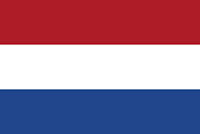 |
| Netherlands flag |
The Dutch player doesn't represent any one player on the team, but rather is a composite. I didn't know as much about the team and only saw their last two games in their entirety. I must admit I had some mixed emotions watching the final. Of course I was cheering for the U.S. team, but I had to admire the Dutch team, too, and it was hard to see them lose.
 |
| Windmill embroidery design |
By the quarter finals, I had ancestral roots in six of the countries of the teams involved and three other countries that did not get that far. But my deepest connections are with the Netherlands. I am "Double Dutch" — Frieslander on my father's side and mainland Dutch on my mother's. Of my European ancestors (I also have Native American ancestry), the Dutch were the first to come to America. They settled here in the late 1600's — influenced by Peter Stuyvesant — and remained for a long time, while New York was still New Amsterdam, before moving westward. When our family traveled in Europe many years ago, the Dutch people were the most welcoming and helpful of hosts, even bringing out family cradles — and once a beautiful Louis XV crib — for our youngest, who was just a baby. One hotel manager's wife volunteered to babysit all three children so my husband and I could have a special meal of foods from the former Dutch East Indies at a nearby restaurant.
************************
 |
| Original design with white background |
Now let's consider the project I started on
a post from last month. I mentioned that I wanted to "flood the background" of the design — which I had left white — with other colors to see how they compared. J.D. did this electronically. Here are the ones we liked best:
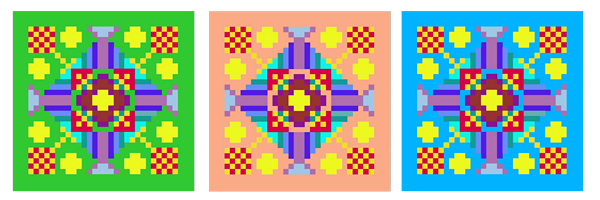 |
| Original design with a variety of colored backgrounds |
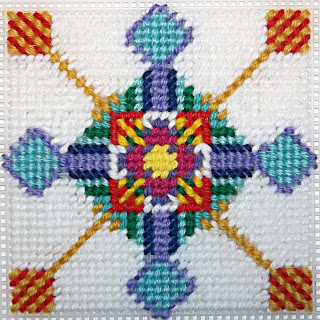 |
| Needlepoint, early stages |
I have completed the original design in tent stitch on #10 canvas, which made the design quite a bit smaller than the original sketch on quarter-inch graph paper. However, I think the closely stitched design shows up more vividly than the paper design. I had already added dark and bright red and bright and antique gold to the central design on the original pattern to balance all the blues, greens and violets. Now I added a few stitches of red-violet and re-shaped the white "brackets" on the four sides. I moved the corner designs to areas about three inches from the center of the canvas, connecting them with lines of the antique gold. I was dissatisfied with the open ends of the purple-&-aqua motifs on the sides of the central medallion, so I closed the ends with and arc of stitches and filled in the entire center of the shape I had created. At that point, I stopped working on the design itself and filled in the white areas of background out to the edges of the completed part of the design.

I am describing the colors as
I see them on my canvas. It is virtually impossible to match yarn exactly to the colors of colored pencils and marking pens and get the identical visual effect. Furthermore, the colors you see on your screen are probably not exactly the same colors I see on my canvas. They are not even exactly the same colors J.D. gets on his camera images or his monitor. So I try to name the colors as I proceed so that you can make your own decisions about what you like and do not like.
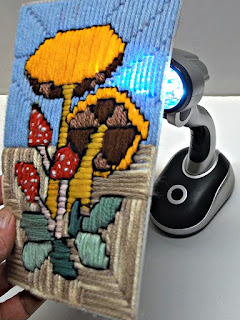 |
| Using a strong light to check stitching |
Something that I do repeatedly when I do canvas work is to hold the canvas up to a strong light periodically as I stitch. This immediately tells me if I have missed a stitch anywhere. It also shows me of areas where stitches may look thin enough to let some light through. If these are just random stitches, I choose a needle with the appropriate color of yarn or floss and stitch over the thin stitches, pulling the doubled stitch down firmly.. Sometimes, however, a whole line of stitches looks thinner than those around it. Before you stitch over the whole row, try this. Run a strip of the yarn or floss under stitches on the
back of the canvas, along-side the thinner stitches. Check them with the light again. Often this simple act will correct your problem. If you are working with heavy yarns or flosses, it may be a good idea to separate some strands and use them to fill in stitches, rather than to double its thickness — which may be more noticeable than the thinner stitches.
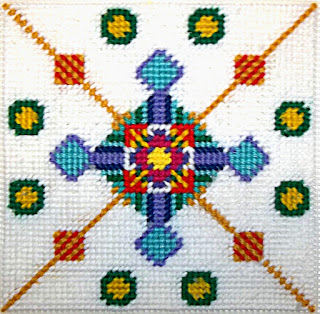 |
| Needlepoint, later stages |
Because I liked the symmetrical areas of white background, I moved the small 8-pointed motifs in bright gold farther out from the center, beyond the second array of motifs. I still wanted to use them, however, and to make them stand out against the white background. First I placed them symmetrically around the portion of the canvas that was already worked. (I left the corners open because I had not yet decided whether to extend the corner motifs.) Then I edged each one with a row of stitches in the emerald green yarn used in the stripes at the sides of the central design. Still leaving the corners open, I filled in around the new motifs with the white background yarn. Then I did extend the antique gold rows of stitches to the corners of the completed area.
I made the ends of the antique gold lines into arrowhead-like points similar to those that complete the central square of the design. I then looked around at the collection of colorful yarns I had used in the design and decided to use them, one-at-a-time, for borders until I ran out of canvas. So that's what I did. As you can see, i have modified the original pattern considerably— but I did warn you that I probably would do so. If I were to use the pattern on a different kind of project, such as a rug, I would modify it in an entirely different way.
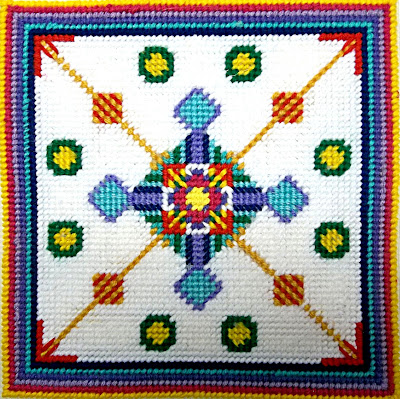 |
| Finished needlepoint |
Make something unique with your own color choices.






 This post by Annake's Garden is licensed under a Creative Commons Attribution-NonCommercial-ShareAlike 3.0 Unported License.
This post by Annake's Garden is licensed under a Creative Commons Attribution-NonCommercial-ShareAlike 3.0 Unported License.
